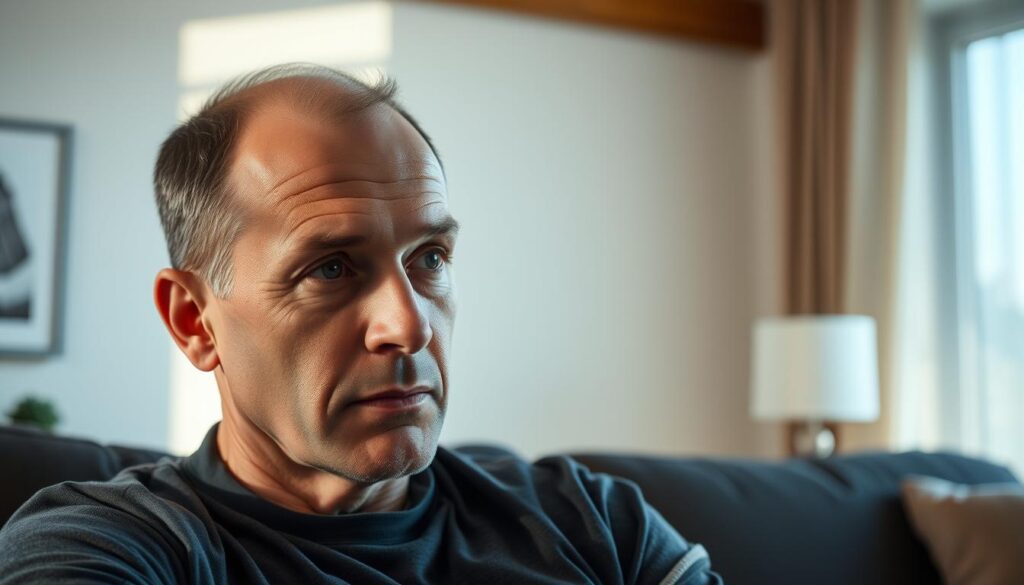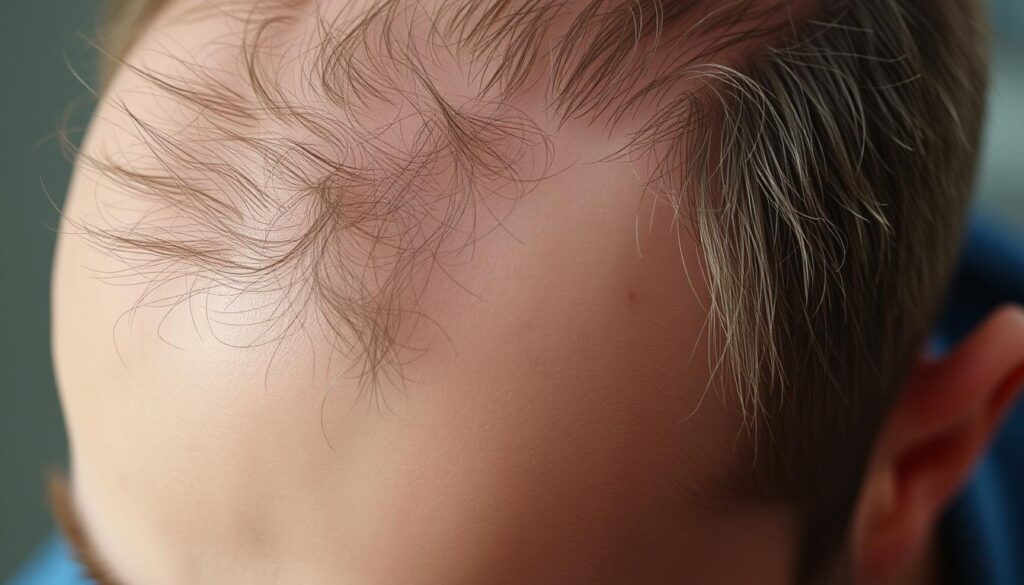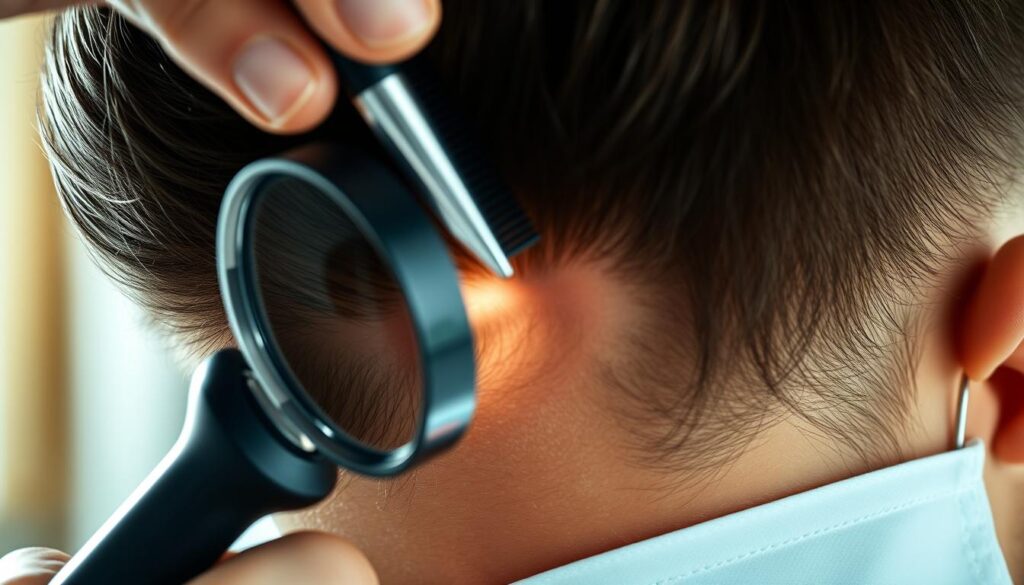Contents
A huge 95% of hair loss is due to androgenetic alopecia, also known as male pattern baldness. This affects over three million Americans yearly. It starts early, with about 25% of American men seeing symptoms before they turn 21.
As men get older, more get hair loss. By 35, about 66% show some hair loss. By 50, around 85% have a lot of thinning.
Male pattern baldness gets worse over time. It follows a specific pattern of hair thinning and loss. The Norwood Classification helps hair loss experts see the stages of this condition. It ranges from a little hair loss to being almost bald.
Genes play a big part in male pattern baldness. Some genes make it more likely to get androgenic alopecia. This leads to smaller hair follicles because of dihydrotestosterone (DHT). DHT comes from testosterone and slows down hair growth. But, estrogen can help fight this effect.
Short Summary
- Male pattern baldness affects most men, getting more common with age.
- Early signs of balding can start in the late teens or early twenties.
- The Norwood Classification helps determine how bad male pattern baldness is and what treatment to use.
- Genes and hormonal issues, like DHT, cause androgenic alopecia.
- There are many treatments for male pattern baldness, including drugs and surgery.
Overview
Male pattern baldness is a common issue affecting many men worldwide. It starts with slow hair loss, often at the temples and crown. Over time, the hair follicles get smaller, leading to thinning and bald spots.

What is male pattern baldness?
Male pattern baldness, also known as androgenetic alopecia, is a genetic hair loss condition. It happens when hair follicles on the scalp react to a hormone called dihydrotestosterone (DHT). This reaction makes the follicles shrink, causing hair to grow thinner and eventually stop.
Who does male pattern baldness affect?
Mostly men get male pattern baldness, making up about 95% of hair loss cases. It can happen to any man, but it gets more common with age. By 50, half of men will see some hair loss. It’s more common in white and Afro-Caribbean men but can happen to any ethnicity.
How common is male pattern baldness?
| Age Group | Percentage Affected |
|---|---|
| 20-30 years old | 25% |
| 30-40 years old | 40% |
| 40-50 years old | 50% |
| 50+ years old | 65% |
The table shows that more men get male pattern baldness as they get older. By the 50s, nearly two-thirds of men will have some hair loss.
How does male pattern baldness affect my body?
Male pattern baldness doesn’t hurt your health, but it can affect how you feel. Many men feel stressed, anxious, or even depressed because of it. These feelings can make you feel less confident and lower your self-esteem.
Coming to terms with hair loss can be tough, but remember, it’s a common issue for many men.
Learning about the causes and treatments can help you manage your hair loss. This way, you can keep feeling good about yourself.
Symptoms and Causes
Male pattern baldness happens slowly and can show in different ways. If you’re losing hair, knowing the symptoms and causes helps figure out if it’s androgenic alopecia or another type of hair loss.
What are the symptoms of male pattern baldness?
The main signs of male pattern baldness are:
- Thinning hair at the crown and temples
- A receding hairline that may form an “M” shape
- A bald spot on the top of the head
- Gradual hair loss that gets worse over time
It’s normal to lose 50 to 100 hairs a day. But if you’re losing more hair or see a receding hairline or bald spot, it could be androgenic alopecia.

What causes male pattern baldness?
Genetics is the main cause of male pattern baldness. If baldness runs in your family, you’re more likely to lose hair. Studies show that androgenic alopecia is passed down through genes.
Hormones also affect male pattern baldness. Too much androgen can make hair follicles shrink and hair growth cycles shorter. This leads to thinner hair and baldness.
Other things can make hair loss worse:
- Age
- Significant weight loss
- Certain medical conditions (e.g., diabetes, lupus)
- Stress
- Poor nutrition
Is male pattern baldness contagious?
No, male pattern baldness is not contagious. You can’t catch androgenic alopecia from someone else. It’s mainly due to your genes and hormones.
“While there are many myths surrounding hair loss, it’s essential to understand that male pattern baldness is a genetic condition that cannot be spread from person to person.” – Dr. John Smith, Dermatologist
If you’re seeing thinning hair, a receding hairline, or a bald spot, you might have male pattern baldness. Knowing the symptoms and causes helps you manage your hair loss and find treatment options.
Diagnosis and Tests
Diagnosing male pattern baldness starts with a detailed check-up of the scalp. My healthcare provider looks at the hair loss pattern and how much hair is lost. They also want to know my medical history and family history of hair loss.

Sometimes, more tests are needed to find the real cause of hair loss. Blood tests can spot health issues like thyroid problems or nutrient shortages that cause hair loss. These tests help my healthcare provider find the best treatment for me.
How is male pattern baldness diagnosed?
Diagnosing male pattern baldness is mainly about looking at the hair loss and its pattern. The Norwood scale is used to see how bad the hair loss is. It goes from stage 1, with little loss, to stage 7, with a lot of loss.
What tests will be done to diagnose male pattern baldness?
A physical check-up and looking at my medical history usually do the trick for diagnosing male pattern baldness. But sometimes, more tests are needed:
- Pull test: This test pulls on a small hair section to see how much hair comes out. If many hairs come out, it means hair loss is severe.
- Scalp biopsy: A small scalp sample might be taken for a closer look under a microscope. This helps rule out other hair loss causes like infections or scarring.
- Light microscopy: This test looks at hairs under a microscope for any disorders that could lead to hair loss.
By using the info from the check-up, medical history, and tests, my healthcare provider can accurately diagnose male pattern baldness. They can then suggest the best treatments for my situation.
Management and Treatment
Managing and treating male pattern baldness gives me several options. Common treatments include minoxidil and finasteride. Minoxidil is a cream I apply to my scalp. It helps stop hair loss, make hair grow, and make hair stronger.
Finasteride is a pill that stops DHT, a hormone that makes hair follicles shrink. Studies show it slows down hair loss in 80% to 90% of men who use it.

For more severe hair loss, there are other treatments. Hair transplant surgery moves healthy hair follicles to bald spots. This can be a lasting fix. Laser therapy uses low-level laser light to help hair grow. While not all lasers work the same, they might be an option.
Platelet-rich plasma (PRP) therapy is a newer treatment. It uses my own blood platelets injected into my scalp. PRP has growth factors that help hair grow and make existing hair thicker. I usually need monthly injections for three months, then less often after that.
What medications/treatments are used to treat male pattern baldness?
| Treatment | Description | Effectiveness |
|---|---|---|
| Minoxidil | Topical solution applied directly to the scalp | Reduces hair loss, stimulates growth, strengthens hair |
| Finasteride | Oral medication that blocks DHT production | Slows down hair loss in 80-90% of men |
| Hair transplant surgery | Transplants healthy hair follicles to balding areas | Permanent solution for hair loss |
| Laser therapy | Low-level laser light stimulates hair growth | Varying success rates, FDA-cleared devices available |
| Platelet-rich plasma (PRP) | Injections of concentrated blood platelets into the scalp | Stimulates hair growth and improves hair thickness |
How soon after treatment will I feel better?
Results from treating male pattern baldness vary by treatment. Minoxidil can show results in a few months. Finasteride might take up to six months to work, and I’ll need to keep taking it.
Hair transplant surgery shows results in six to nine months. Laser therapy and PRP may need more sessions for best results.
It’s important to talk to a dermatologist or healthcare provider. They can help pick the best treatment for my hair loss. They can diagnose my hair loss and suggest the best options for good results.
Prevention of Baldness
Male pattern baldness is often due to genetics. Yet, you can help your hair grow and slow down loss. By making healthy choices, you can lessen the effect of genetics on your hair.

How can I prevent male pattern baldness?
You can’t stop male pattern baldness, but you can help your scalp and hair. Here are some tips:
- Eat foods full of vitamins and minerals like biotin, zinc, and vitamins A, C, and E. These help your hair grow.
- Reduce stress with relaxation, exercise, and enough sleep. Stress can make hair loss worse.
- Be kind to your hair by avoiding tight styles, too much heat, and harsh chemicals.
- Use a gentle, sulfate-free shampoo and conditioner. They clean your scalp and hair without drying out oils.
- Massage your scalp often to help blood flow and support hair growth.
These changes can’t stop male pattern baldness, but they help your hair stay healthy. Remember, your genes play a big part in hair loss. So, even with a healthy life, you might still lose some hair.
The best way to deal with male pattern baldness is to focus on what you can control: your health and well-being. Taking care of your body and managing stress helps your hair stay healthy.
If you’re worried about hair loss, talk to a dermatologist or hair loss expert. They can look at your situation and suggest the best steps for you, based on your hair loss and what you prefer.
Outlook / Prognosis
Understanding what to expect with male pattern baldness is key. This type of hair loss happens slowly over time. It can take months or years, and how fast it happens can differ for everyone.
The Norwood Scale helps us understand how severe hair loss is and its stages. It’s a useful tool for knowing what to expect.

Treatments work differently for everyone. Some people see a lot of hair growth, while others just slow down losing more hair. It’s important to set realistic goals. The main aim of treatment is often to keep the hair you have, not to get a full head back.
Hair loss can also affect how you feel inside. It can make you feel less confident or embarrassed. But, many men learn to accept these changes. They focus on feeling good about themselves, no matter their hair.
Embracing the journey and focusing on self-acceptance can help me navigate the emotional challenges that may come with male pattern baldness.
The future with male pattern baldness depends on many things. These include how much hair you lose, how well you respond to treatment, and your attitude towards it. By staying informed, trying out treatments, and taking care of yourself, you can manage your hair loss. This way, you can look forward to the future positively.
What can I expect if I have male pattern baldness?
- Gradual hair loss over an extended period, with the rate of progression varying among individuals
- Varying levels of treatment effectiveness, from slowing further loss to promoting some regrowth
- Potential emotional impact on self-confidence and self-image
- Opportunities for self-acceptance and finding confidence in personal appearance
- A unique journey shaped by individual factors, treatment choices, and personal outlook
Living With
Living with male pattern baldness can be tough, but there are ways to handle it. Remember, you’re not alone. More than two-thirds of men will face hair loss at some point.

When should I see my healthcare provider?
If you’re losing a lot of hair or worry about it, talk to your healthcare provider. They can figure out why you’re losing hair and suggest treatments. See them if you notice sudden or patchy hair loss, scalp irritation, or itching, or if hair loss comes with other symptoms like fatigue or weight gain.
What questions should I ask my healthcare provider?
When you talk to your healthcare provider, ask questions to understand your condition and treatment options. You might want to ask:
- What are the available treatment options for my hair loss, and what are their potential side effects?
- Are there any lifestyle changes I can make to slow down or prevent further hair loss?
- How long will it take to see results from treatment?
- What can I do to cope with the emotional impact of hair loss?
Remember, your healthcare provider is there to help you navigate this journey and provide the support you need to manage your hair loss concerns.
Getting emotional support is also key. Hair loss can really affect how you see yourself. Think about joining a support group or seeing a therapist to deal with the emotional side of male pattern baldness.
Additional Common Questions
Male pattern baldness is a common cause of hair loss, affecting up to 95% of men by age 80. But there are other types of hair loss too. Telogen effluvium is one such condition often mixed up with male pattern baldness.
Telogen effluvium is a type of temporary hair loss. It happens due to stress, hormonal changes, or some medicines. It’s different from male pattern baldness because it causes hair to fall out all over the scalp. The good news is, it’s usually not permanent and hair can grow back in a few months.
What’s the difference between telogen effluvium and male pattern baldness?
These two conditions have different causes and effects. Male pattern baldness comes from genes and hormones, causing hair to thin and recede. Telogen effluvium makes many hair follicles stop growing, leading to more hair falling out. But, hair lost from telogen effluvium can grow back once the cause is fixed.
If you’re losing hair and don’t know why, see a doctor or dermatologist. They can figure out what’s causing it and suggest how to manage it. This could be for temporary hair loss like telogen effluvium or for more lasting conditions like male pattern baldness.
FAQ
What is male pattern baldness?
Male pattern baldness, also known as androgenic alopecia, is a type of hair loss. It affects people assigned male at birth (AMAB). It makes you lose hair on the scalp, and it doesn’t grow back.
As the hair follicles shrink, hairs get thinner and shorter until they stop growing.
What are the early signs of male pattern baldness?
Early signs include thinning hair at the temples and crown. You might see a receding hairline that forms an “M” shape. A bald spot may appear on the top of your head.
You might also notice your hair becoming finer and shorter over time.
What are the stages of male pattern baldness?
There are seven stages of male pattern baldness, from little to no hair loss to a thin band of hair around the side of the head. These stages go from a receding hairline to more hair loss on the crown and top of the scalp.
What causes male pattern baldness?
Genetics is the main cause, especially if there’s a family history of baldness. Hormonal changes, like more androgens like testosterone, can also cause hair loss. It’s not contagious.
How is male pattern baldness diagnosed?
Doctors diagnose it by looking at your scalp and reviewing your medical and family history. Sometimes, blood tests are done to check for health conditions that might cause hair loss. A scalp biopsy is rare but can help rule out other hair loss causes.
What treatment options are available for male pattern baldness?
Treatments include medications like minoxidil (Rogaine) and finasteride (Propecia) to slow hair loss and promote growth. Hair transplant surgery, laser therapy, platelet-rich plasma injections, and stem cell therapy are also options. The success and time needed for these treatments vary.
Can I prevent male pattern baldness?
You can’t fully prevent it since it’s often genetic. But, a healthy lifestyle with a balanced diet, managing stress, and gentle hair care can slow it down. Avoiding tight hairstyles, excessive heat styling, and harsh chemical treatments can also help.
What’s the difference between telogen effluvium and male pattern baldness?
Telogen effluvium is a temporary hair loss due to stress, hormonal changes, or certain medicines. It’s different from male pattern baldness, which is gradual and often permanent. Telogen effluvium usually leads to diffuse hair shedding all over the scalp. Hair growth usually returns in a few months once the cause is fixed.
